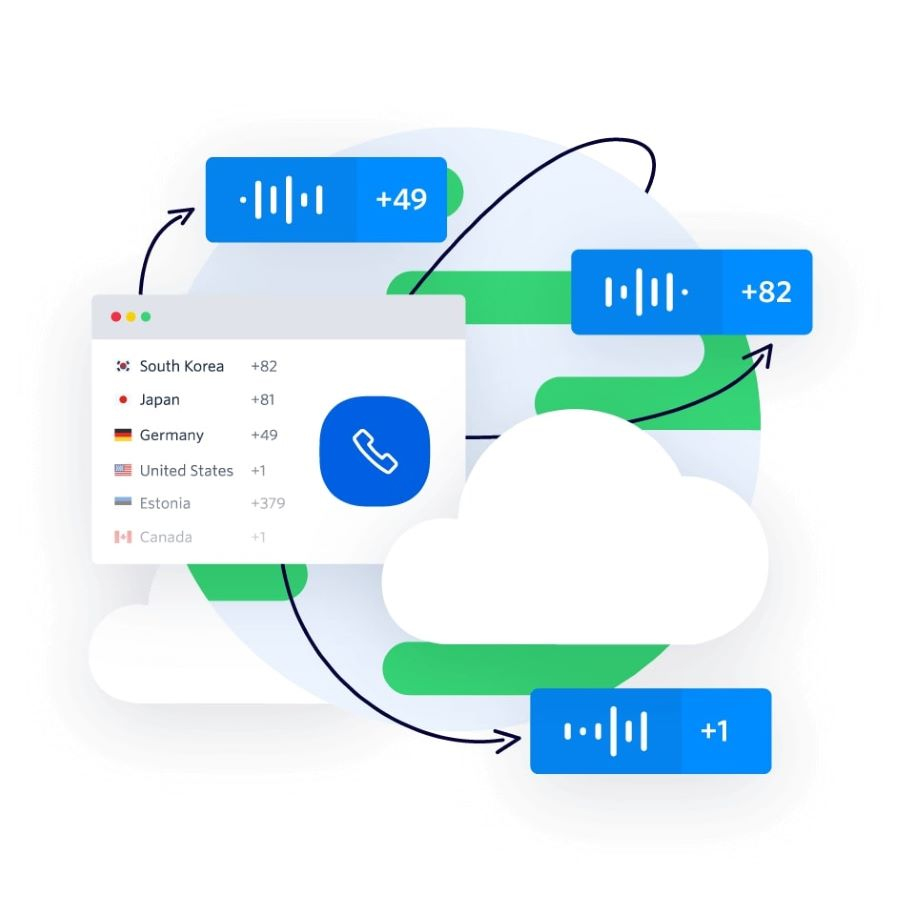Session Initiation Protocol (SIP) trunking is a communication protocol for sending and receiving communications over the internet through private branch exchange (PBX) equipment. The most common applications for SIP are voice and video calls and instant messaging over internet protocol (IP) networks. This technology enables your on-premise phone system to benefit from unified communications (UC) services like video conferencing, encryption, and 911 services.
Keep reading to answer the question, “What is SIP trunking?” and learn how it works—plus how it can optimize your business communications.
How SIP Trunking Works
Here, we cover the SIP trunk definition and how the protocol works. Simply put, SIP trunking allows voice and data to be transmitted over the internet simultaneously. It allows businesses to improve internal and external communications using the protocol that initiates and terminates cloud-based communication.
SIP trunks use voice-over-internet-protocol (VoIP) technology to connect an on-premise phone system to the public switched telephone network (PSTN). Below is a simplified summary of how SIP trunking works:
- Use the office phone to make a call, which goes through the PBX phone system.
- Once the phone system identifies the destination of your call, it will deliver the call to your internet telephony service provider (ITSP).
- Next, the ITSP will use SIP trunking to connect the SIP-based PBX to the PSTN.
- The PSTN routes the call around and delivers the call to the ITSP of your recipient.
You may be wondering how SIP trunking and VoIP differ. VoIP refers to any phone call made over the internet. On the other hand, SIP trunking’s definition is: SIP is a protocol that initiates and terminates communication sessions in VoIP platforms, including messaging, voice, and video.
SIP trunks use a packet-switched network to break down voice calls into digital packets and direct them over a network to their destination. The data packets are sent between two or more identified IP endpoints or SIP addresses. SIP does not encode, decode, or transport information during the session. This enables business telephone systems to conduct real-time communications over the internet, such as video conferencing and instant messaging.
SIP trunking replaces your physical infrastructure with a virtual one. When switching to SIP trunking, you will need the following:
- Stable internet connection
- SIP-compatible PBX box or IP PBX
- VoIP phones (and VoIP adapters for traditional phones)
- Network connection for your phones
Our earlier SIP trunk definition highlights that the main objective of SIP trunking is to replace older digital voice services like primary rate interface (PRI) technology. SIP is the technology that creates, modifies, and terminates sessions between two or more parties in an IP network, be it a two-way or multi-party call.
What is PRI? PRI has been used for decades to deliver lines of voice and data using physical copper lines. Essentially, it’s a bundle of analog phone lines put together. PRI can be costly to maintain since the hardware is quickly becoming outdated.
What Is SIP Trunking Used For?
SIP is used worldwide to communicate using computers and mobile devices over the internet. Businesses are increasingly using SIP because of its flexibility and reliability. Small businesses with on-premise phone systems upgrade to SIP trunking to replace expensive dial tone systems with cloud features without sacrificing earlier investments.
SIP trunking is used to leverage existing internet connections—enabling chat, video, and voice calls. As virtual phone lines, it’s used by small to medium businesses to maximize enterprise PBX systems with less spending on hardware and setup. It’s particularly useful for call setup, management, and teardown.
If you’re wondering what is SIP trunking used for, SIP trunking is deployed in various business settings, including the examples highlighted below:
- Overseas calling: SIP trunk connections are a cost-effective solution for businesses making many international calls.
- Temporary increase or seasonal demand: SIP trunk lines are easily added or removed, allowing businesses to adjust their phone system size based on need.
- UC: SIP trunk connections allow for voice calls, video calls, and messaging functions, which is ideal for businesses looking for multiple communication channels besides standard telephoning.
Significant Advantages to Using SIP Trunks
SIP trunking upgrades your business communications by connecting your PBX to a cloud-based phone system, making it scalable and more powerful. From more significant cost savings to unified communications, SIP trunking delivers an optimized user calling experience. Here are other potential benefits of SIP trunking:
With SIP trunks, you can use the same IP-based network for different types of transmission, including voice and video. SIP’s solid infrastructure eliminates the need to subscribe to different voice and data services. A single communication system allows you to scale without adding new services or contracting new providers to support such growth.
SIP trunking eliminates the costs associated with traditional phone lines, such as purchasing PRIs or local PSTN gateways, in-house equipment, and hardware and infrastructure maintenance. Paying per user instead of line-item fees for local and international calls is also significantly cheaper. VoIP SIP trunk providers offer simplified pricing packages based on usage, features, and add-ons.
Since phone lines operate over the internet, there are fewer concerns about physical arrangements for expanding teams, allowing you to grow unhampered. SIP trunking is easily scalable, depending on usage. It makes adding channels and coping with increasing call volumes possible—perfect for fast-growing businesses. SIP trunking allows users to choose the correct number of channels they need instead of paying for lines they don’t use.
This is particularly useful if you have increased seasonal phone traffic. You can scale your phone system to meet customer needs by adding more channels to accommodate calls temporarily. Also, there is no need to worry about physical installations since most providers offer unlimited capacity.
One of the huge advantages of SIP trunking is the flexibility and mobility it gives your team. Unlike traditional phone lines, SIP trunks are not tied to a local exchange. SIP numbers are portable, allowing voice calls to be easily routed to people’s mobile devices, making them accessible even when working remotely.
Use a handset, portable tablet, or computer to make and receive phone calls. This means real-time connectivity between the office and field personnel or open access of customers to your staff.
Traditional telephone services are easily disrupted by bad weather, equipment failure, or network issues. SIP trunking with VoIP is more reliable than traditional phone systems and allows users to keep using their phones by routing calls to other devices or lines. The right SIP trunking provider should provide a disaster preparedness plan for troubleshooting.
SIP trunking offers UC services, such as team messaging, analytics, call tracking, and screening for better operations and customer support. Since SIP trunks are cloud-based, users can access real-time data insights that accurately measure call center performance.
If you’re ready to scale up your business phone system with SIP trunking, learn how to set up a VoIP system to access enhanced communications services like team messaging and video conferencing.
Getting Started With SIP Trunking
There are many SIP and VoIP service providers in the market. Since each business has different needs, the SIP trunking provider you choose ultimately affects your growth and performance. When purchasing a SIP trunking solution and selecting a provider, keep these factors in mind:
Take time to understand your communication needs. Knowing the ins and outs of your call traffic patterns allows you to estimate your required bandwidth for efficient operations. Think about your team size, how many lines, and how much bandwidth you need.
Look at the security features offered by the different providers you’re considering. A good SIP trunk provider has a clear data policy and secure network, protecting your data against cyberattacks and hacking methods. Find out the security measures they put in place, such as levels of encryption, and whether they have an anti-fraud system.
Companies use SIP trunks to improve their communications experiences while reducing overall expenses. With this in mind, carefully consider what each SIP trunk provider offers and see if these are features you need. Below are some of the top SIP trunking features for small businesses:
- E911: This feature, also known as “nomadic 911,” gives you and your team peace of mind that you have access to emergency services. E911 automatically routes your call to your location’s local emergency center.
- Caller ID: Most SIP trunks support customizable inbound and outbound caller ID. This allows businesses to set their users or business name.
- Call data records: This provides valuable insights regarding communication history and call performance. With SIP, access real-time, accurate data to understand your areas of improvement and best practices.
- Voicemail: SIP trunking and VoIP systems offer basic or advanced voicemail. This feature enables companies to retrieve and respond to voice messages left by customers. Some providers also transcribe messages and send them to your email.
Think about how much your business can spend each month. SIP trunk pricing varies across providers, with most platforms charging per-user or monthly rates. Monthly SIP trunks cost about $15 to $25 per line. Many offer annual billing or volume-based discounts, which greatly help small businesses. Review bundle offers carefully to ensure they fit your usage and needed services.
The cost of setting up SIP trunks varies greatly depending on your supplier and the services they offer. The initial setup cost for SIP trunking depends on your existing PBX hardware and whether you can reuse compatible equipment. Initial investment ranges between $500 to $2,000, but once set up, it costs about $15 to $30 per line.
A SIP trunking provider should keep your business running despite emergencies, disasters, or peak hours. They should have a disaster recovery plan for business continuity and ensure you can cope with any situation. Some measures providers offer include business-grade data centers and proactive networking monitoring for quality and security assurance.
The Best SIP Trunking Providers
More and more businesses have turned to SIP trunking to cut costs and improve communication capabilities. With several SIP trunking providers available, it’s important to look at their pricing plans, features, and service guarantees, as these vary significantly from one provider to another. We’ve already picked the best options to narrow down your choice.
Here are the best SIP trunking providers for a seamless transition of your phone system:
Frequently Asked Questions (FAQs)
What do I need for SIP trunking?
SIP trunks require a stable internet connection with good bandwidth, SIP-compatible PBX equipment, and VoIP-compatible phones.
What are the common problems with SIP trunking?
SIP trunks offer benefits such as improved communication and lower costs, but there are possible drawbacks. Some small businesses find the initial SIP trunk investment steep, especially if your existing PBX equipment is incompatible with your chosen provider. Lastly, businesses with internet connectivity issues may encounter call quality issues and decreased productivity.
How many channels can SIP trunks handle?
An SIP channel is used for an incoming or outgoing call. You will need at least one SIP channel for each call, and there is no limit to the number of channels a SIP trunk can have. As your company grows, you will likely need more SIP trunks.
Bottom Line
The answer to the question, “what is SIP trunking?” is simple. SIP trunk services revolutionize business phone systems by offering flexible, internet-based solutions compared to traditional telephone lines. SIP trunks help initiate and keep VoIP calls smooth and collaboration much more efficient. This is an excellent choice for fast-growing companies seeking solutions to minimize telecom spending.
RingCentral is our pick for the best overall SIP trunking solution because of its feature-rich services like advanced reporting and team messaging. However, smaller teams looking for a flexible SIP trunking provider should consider Twilio’s Elastic SIP Trunking. It offers access to on-demand cloud features and pay-as-you-go pricing plans for better global connectivity.


